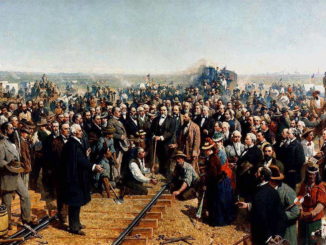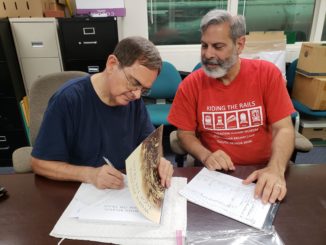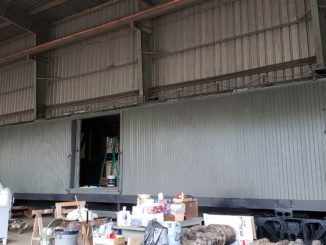Lloyd Neal
J.R. Shipp was born on a farm close to the railroad tracks in Hiram, Georgia on January 2, 1926. He decided that farm work was not for him. He wanted a job. When old enough he left home to work at the old Sears on Ponce de Leon Avenue in Atlanta.
While working at Sears he visited the Southern Railway North Avenue Yard constantly. The railroad workers got tired of seeing him and offered him a job at 37 and ½ cents per hour.
He started working for the Southern Railway on February 1, 1943 at the age of 17. His first duties were to supply cabooses in the yard. Coal or heating oil for the stove, Kerosene for lamps, ice for the cooler, various paperwork forms and so on. Fresh water came from an old well bucket poured into a water cooler located in the caboose.
He transferred to the Supply Department storeroom at North Avenue Yard at some point. This was an important job in his career. J.R. became “railroad educated to know what he was doing” after this job. He worked with railroad employees who had a variety of jobs. He learned by listening to them talk.
He left the railroad after almost a year of employment when he turned 18 due to the war time Draft. He joined the Navy and served as a Gunner Seaman 1st Class on a Marine ship during World War II. He was honorably discharged after the end of the war.
He returned to the railroad and entered train service working as a brakeman. He later became a conductor as his seniority increased with the railroad. Once you became a conductor you retained that job due to seniority.
There was not enough work at the railroad when he returned after World War II. He secured a job with Atlanta Transit working two jobs at the same time. He worked as a driver for trolley cars, trolley buses and diesel buses. He even drove some buses to Athens for ball games.
He worked on freight car switching at night at North Avenue Yard. The cars were switched before they were transferred to the main Southern Railway yard in Atlanta, Inman Yard. He worked with steam engines there until they were replaced by diesels.
He later worked a combination of passenger service and freight service. He bought a passenger uniform for his passenger train service. J.R. worked a variety of trains but did not have a regular, recurring, conductor job.
J.R. developed knowledge of the Union Rules Book. J.R. called the union rule books his “greenback books.” J.R. said that the union rule book was most important to him. He used the union rules to his advantage to further his career and for his protection. J.R. said he tried to stay out of trouble. He tried to do what he was told to do.
J.R. got caught violating company rules on one occasion. J.R. had the union rule book open on his lap when the Trainmaster came through the train. “Shipp, you know you are not supposed to read on the job!” J.R. thought quickly and responded, “Do you know what the Rule of the Week is?” The Trainmaster said no more and left. The Trainmaster did not know the Rule of the Week that is posted at all terminals. J.R. out smarted the Trainmaster. And, he was not reported for violating company rules.
Cabooses were not air conditioned. But, J.R. invented his own form of air conditioning to survive hot Georgia summers. The cabooses were equipped with an oak ice box. A 50 to 100 pound block of ice was placed in the ice box for cooling the train crew’s water. J.R. would cut a small block off the large block of ice. He then placed the small block of ice on the window sill of the caboose. J.R. had air conditioning when his train was in motion.
J.R. worked as the conductor on a steam excursion trip. He kept his eyes open and bid on the job when it became available.
J.R. said that he enjoyed his railroad work. He had a good time working at the North Avenue Coach Yard.
The biggest change he saw over his career was the change to the 8 hour day, 40 hour work week. When he started you worked sunrise to sunset for a 16 hour day.
J.R.’s career came to an end when he retired on January 4, 1988. He worked for the railroad for 43 years with the two year break for his military service. The railroad gave him credit for his military time in computing his years of service as 45 years from his date of his first employment with the railroad.
In the companion article John Marbury questioned how J.R. knew so many people with the railroad who worked in other crafts (or departments). I think the answer is from J.R.’s days in the Storeroom. The Storeroom exposed him to employees in the other crafts. J.R. maintained these contacts over the years. So yes, they did work with J.R. The old adage “It is not what you know, but who you know” that helped J.R. through the years.
J.R. passed away on April 11, 2016. My conversation with him took place a month before on March 7, 2016.



